The War of the Roses
ACT ONE:
The Man Who Would
Be King
|
|
|
The
War of
the Roses was a brutal
Civil War between two powerful families over who
would be the next English King.
After
the
Hundred Years War
(1337-1453) had fizzled out under Henry VI, the
weakling son of the great Henry V, the consensus was
the man had lost his mind. Henry VI was so
incompetent that
the English nobles appointed Richard Plantagenet,
Duke of York, to run the show. The House of
Lancaster had been in charge for the past 50 years.
They were not at all pleased to see a York man in
charge.
The competition to replace Henry VI
became the spark
that ignited The War of the Roses
(1455-1487),
32 year stretch when one man
after another took his best shot at obtaining the
throne. Four different wars were fought and
lots of people died in the process.
On one side was the
House of
Lancaster whose symbol was a red rose. Opposing them was
the House of York whose symbol was a white rose.
Hence the name.
One
unusual twist to the rivalry was the fact that many
of the participants were related to each other.
Since neither side had any better claim
to the throne than the other, they decided to fight
it out. The carnage was incredible.
In the end, only one person
came out smelling like Roses.
William Shakespeare wrote eight plays. To him,
this period was the gift that kept on giving.
|
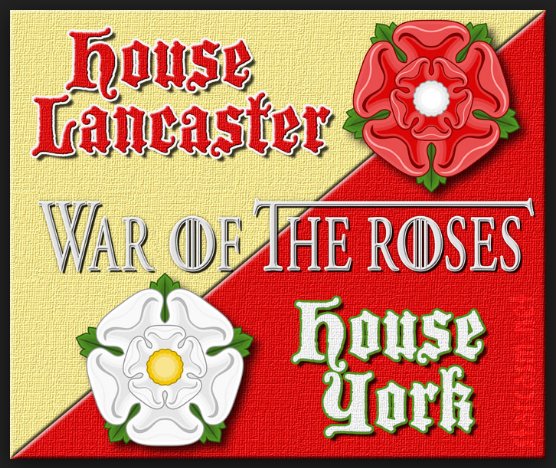 |
 |
The houses of Lancaster
and York correspond to
the modern counties of Lancashire
and Yorkshire.
The War of
the Roses saw the Yorks and
Lancasters play musical chairs with
the English throne. Starting with
Henry IV, the Lancasters had been in
charge for 50 years. Now the Yorks wanted their day in the sun.
Both
sides gained and lost power multiple
times. In total, the Wars
resulted in five different rulers in the span of
only 25 years, three of whom were killed or executed
by their rivals.
Have you
ever heard of the Lannisters? Have you
ever heard of the Starks? Lannisters =
Lancasters, Starks = Yorks.
The exciting HBO series
Game of Thrones was inspired by the
wildly improbable twists and turns seen
during the War of the Roses.
The War
of the Roses was so brutal it made Game of Thrones
look like kids fighting with wooden swords. It
even had dragons!!
Well,
maybe not. But it should have.
|
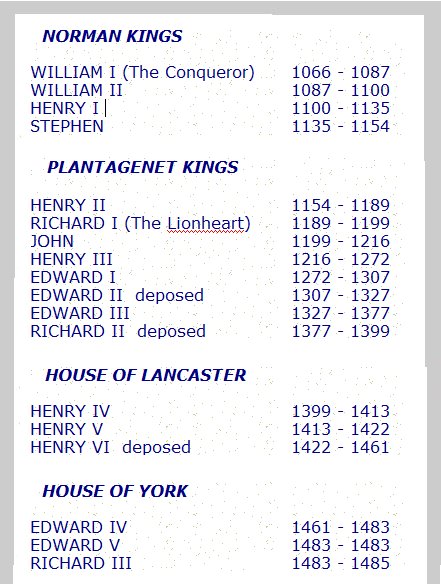 |
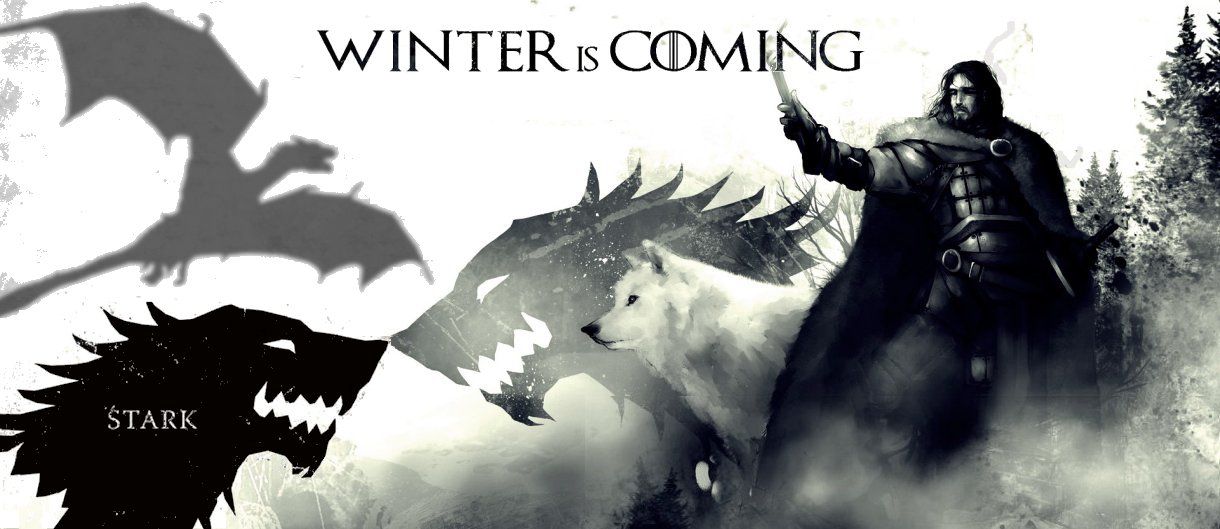
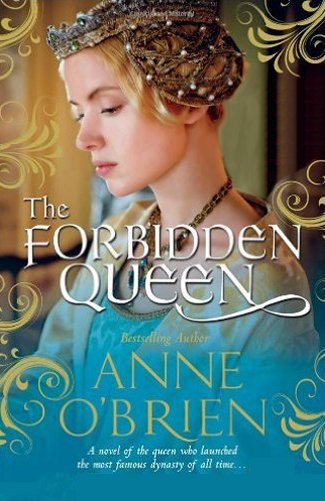 |
Catherine of
Valois
1415. The jewel in the French crown, Katherine de
Valois, is waiting under lock and key for King Henry
V.
While
the English superman is slaughtering her
kinsmen at Agincourt,
Catherine is praying for
marriage to save her from her misery. But the brutal
king wants her crown, not her innocent love.
For Catherine, England is a lion's den of greed,
avarice and mistrust.
And when she is widowed at
twenty-one, she becomes a prize ripe for the
taking—her young son the future monarch, her hand in
marriage worth a kingdom.
This is a deadly political game, one the dowager
queen must learn fast. She
is an innocent pawn in a
kingdom without a king.
The players—the Duke of Gloucester, Edmund
Beaufort and Owen Tudor—are circling.
Catherine de Valois... Who will have her?
Who will
ruin her? A new dynasty will reign…
|
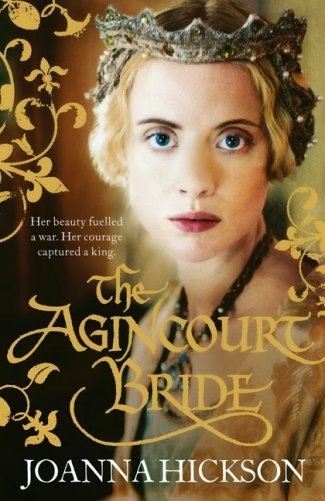 |
| |
|
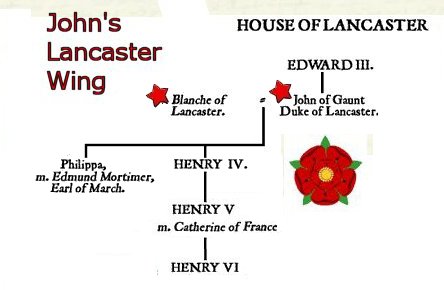 |
As we
shall discover, Catherine of Valois, was an unwanted
Queen in her adopted country. Largely ignored,
she would pass through history virtually unnoticed
yet leave a profound, everlasting effect. As
wife to powerful warrior-king Henry V, Catherine
unwittingly played an important role in the upcoming
War of the Roses.
Catherine (1401–1437) was the daughter
of Charles VI of France. Catherine's older
sister Isabella was queen of England from 1396 until
1399, as the child bride of Richard II. Henry
V had been betrothed to Catherine even after the
great English victory at Agincourt. Despite the
French humiliation, plans for the marriage
continued. Catherine was very attractive.
When Henry finally met her at Meulan, he became
enamored. In 1420, after a peace agreement was made
between England and France, Catherine and Henry were
married.
Catherine went to England with her new husband and
was crowned queen in February 1421. Four months
later, Henry returned to France to continue his
military campaigns during the Hundred Year's War.
One would think being married to the daughter of the
French King would calm Henry down, but apparently
not. He was still determined to be the King of
France.
Catherine was several months pregnant when Henry
left. She gave birth to Henry VI. Her
husband never saw their child. During the siege of
Meaux, he became sick with dysentery and died on 31
August 1422. Catherine was not quite 21 and
was left a queen dowager. What would the
future hold in this foreign land?
|
| |
|
Acclaimed author Anne O’Brien
offers her thoughts on
the French woman who found
herself at the heart of
a royal power struggle...
Has there ever been a Queen of England less
acclaimed – so apparently unexceptional –
than Katherine de Valois?
True, she was a Valois princess, daughter of
Charles VI of France and Queen Isabeau; she
became the beautiful young bride of
England’s heroic King Henry V, victor at
Agincourt.
Shakespeare wrote for her a splendid love
scene in Henry V, where Henry declares: “There
is witchcraft on your lips, Kate.”
But Katherine’s early life was not
glamorous, being one of neglect and
starvation, running unwashed and wild
through the Hôtel St-Pol, her father
suffering from bouts of madness, her mother
unapproachable. When packed off to a
convent, Katherine’s education was minimal.
She learned to play the harp.
What she had was royal blood and so she
became a matrimonial prize in the diplomatic
maneuvering to bring peace between England
and France. Henry wanted the French crown
for his descendants, and that is what
Katherine brought as her dowry. Henry would
have wed her had she been the ugliest
princess in Christendom.
This was no
fairytale marriage, and Katherine of course
had no choice in the matter. Nor did life
improve for her as Henry’s
young wife. Out of
the 26 months of their marriage, she spent
only five of them with him in England, and
when left a young widow, she was allowed no
role in the education or upbringing of her
baby son, Henry VI.
Her position was ceremonial, standing beside
the young king when he was crowned or when
he opened parliament.
to be continued...
|
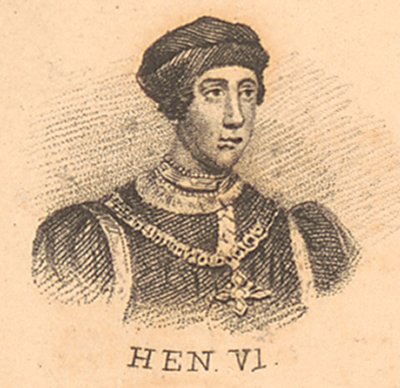 |
Henry VI
Henry VI, son of Catherine of
Valois. Wow! GOAT might stand for
greatest of all time, but not Henry. He was
the other kind of 'goat'. Poor Henry VI.
He was the King who was treated as a pawn. Nice guy,
but gullible and easily manipulated by his powerful
wife Margaret of Anjou. Unlike
his warrior father Henry V, Henry VI was not suited for warfare.
He was much better at praying.
Gentle, pious and retiring, he came to the throne as
a baby. In the process he inherited a losing
war with France. Under his watch, the Hundred
Years War ended in 1453 with the humiliating loss of
all French lands except for Calais. All that
fighting and nothing to show for it. In August 1453, Henry VI
suffered a catastrophic mental breakdown brought on
by the news of the defeat at the Battle of Castillon
in Gascony, the defeat which finally drove English forces from
France.
Henry VI became completely unresponsive
and unable to
speak. He had to be led from room to room.
This had happened before. Mental illness was
hereditary in his mother's family. During these periods of
insanity, he was incompetent to rule.
Previously when this happened, Margaret of Anjou,
his wife, assumed control of his kingdom. But
this attack was far more severe. The Council tried
to carry on as though the king's disability would be
brief, but eventually was forced to admit something
had to be done.
Henry's ineffectual rule
encouraged the nobles to scheme for ways to
establish control over him. In 1454, Richard,
Duke of York, was made Protector of the Realm.
The House of York challenged Henry VI's right to the
throne and England was plunged into civil war.
The War of the Roses was
about to
begin.
|
| |
Richard of York,
Man of Ambition
|
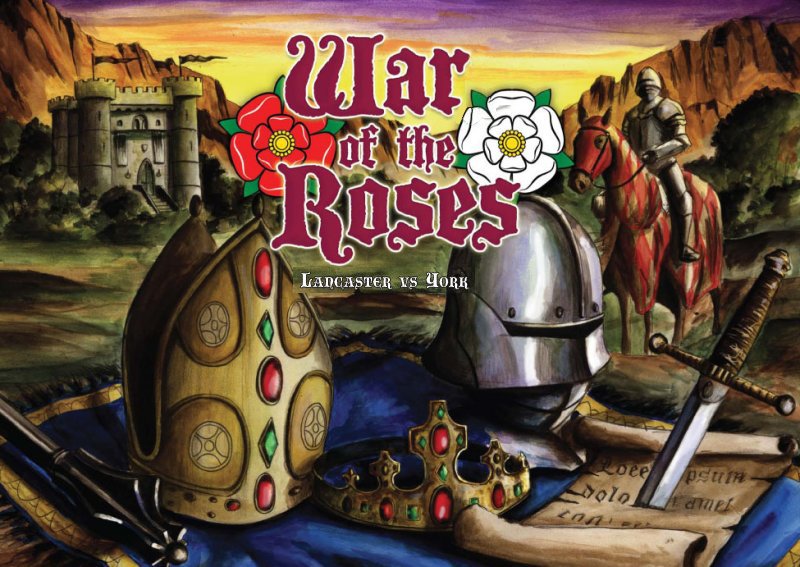 |
Richard
Plantagenet, 3rd Duke of York, was a leading English
noble who wanted to be King. Due to his vast
land holdings in Yorkshire, he was the wealthiest noble in England, second only to the king
himself.
Richard
believed his royal lineage was stronger
than any person in England, including the current
King Henry VI. He based his claim on the
lineage of his two parents.
Richard's grandfather Lionel
preceded John of Gaunt in the birth order of
Edward III. Lionel had only one
child, Philippa. In 1368 Philippa
married Edmund Mortimer, 3rd Earl of March.
Their son Roger Mortimer was the man Henry
IV had 'cheated' out of the throne 50
years earlier.
Lionel's granddaughter, Anne
Mortimer, married into the Yorkist branch of
the English royal family and gave birth to
Richard Plantagenet, 3rd Duke of York.
Richard of York based his claim to the
English throne on this line of descent from
Lionel, who was the eldest son of King
Edward III to establish a lasting blood
line.
|
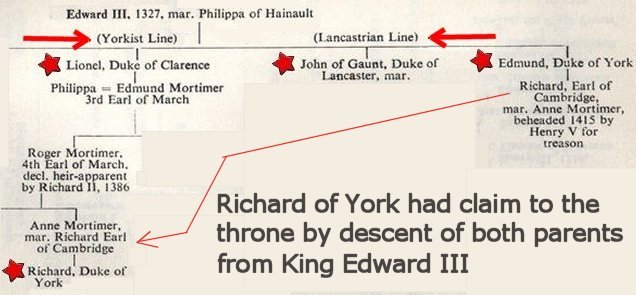 |
| |
|
Second, Richard's father was
Richard, Earl of Cambridge. This made Richard
of York the great-grandson of Edward III on his
mother's side and the grandson of Edward III on his
father's side. Descent from not one, but
two of Edward's sons made for a strong claim.
Richard also had a score to
settle. Henry V had beheaded his father
Richard, Earl of Cambridge, for treason in 1415.
Richard had no love for the House of Lancaster or
for Henry VI, son of the man who murdered his
father.
Richard was certain he had just
as much right to the throne as King Henry VI, the
bumbling Lancaster. Legal scholars agreed with
Richard. Unless Henry VI could produce an
heir, Richard was next in line.
1453 was
an important year in English history. In
January, Richard got the bad news: the Queen
was pregnant. If her child was a boy,
Richard's claims would be negated. Then came
more bad news: England had just lost the
Hundred Year's War. Then came the strange
news: The King had gone mad.
Henry
VI, a weak Lancastrian King, had overseen England's
defeat in the Hundred Years' War. This was the
least of England's problems. Due to poor
leadership, the country was beset with social,
political and economic problems. Popular
revolts were commonplace, triggered by the denial of
numerous freedoms. Lacking leadership, the
rich and powerful English nobles took matters into
their own hands. They raised private armies,
engaged in private feuds and openly defied Henry VI.
England was a land divided.
|
| |
With
Henry's mental breakdown in 1453, this was Richard's
big chance.
Richard
was desperate. Noting that Margaret was
pregnant, he needed to take power now. Even if
the newborn child was a boy, it would be 16 years
before the boy came of age. Richard was
willing to settle for that. A lot can happen
in 16 years. Richard told anyone who would
listen that Henry VI had to go sooner rather than
later.
The
barons and nobles agreed. They also agreed
Richard of York was the best qualified man to run
the state. Richard of York was appointed to
govern as Lord Protector during the madness of King
Henry VI. This move, of course, set in motion
dangerous and far-reaching energies.
The
House of Lancaster was not going sit by idly and let
Richard run roughshod over them. Henry VI was
not dead, he was catatonic. In the eyes of the
Lancasters, Henry was 'resting'. In
their opinion, Henry VI should decide who the next
king should be. Furthermore, wasn't Richard
overlooking something? By amazing timing,
Margaret of Anjou, wife of Henry VI, had just become
pregnant. If she were to have a son, the son's
claim would supersede Richard's claim.
Richard
would have none of it. He intended to pursue
the throne, Margaret's pregnancy be damned.
His unquenchable ambition would soon lead England to
the brink of war.
Matthew
Lewis, biographer of Richard, points out that the
enduring reputation of Richard as villain is unsympathetic and
largely unfair. To begin with, Richard had a
legal claim. Richard had every right to pursue
his claim through political means. He had served loyally as Henry VI’s
lieutenant in France on two occasions and then later
in Ireland. Richard performed his roles
solidly, though unspectacularly. The turmoil
of the 1450s
were largely caused by Lancastrian paranoia
and subsequent infighting to stop Richard.
No doubt
Richard, Duke of York, was a complex man capable of
good as well as evil. That said, there can be
no doubt that Richard would go down in history as
the man whose ambition for the crown sparked the
horrible civil war now known as the War of the
Roses. In the eyes of many people, Richard,
Duke of York, would go down in history as one of the
major
villains.
|
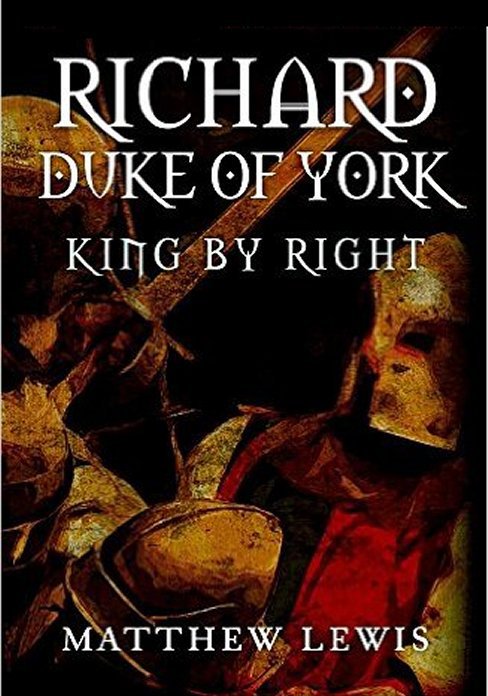 |
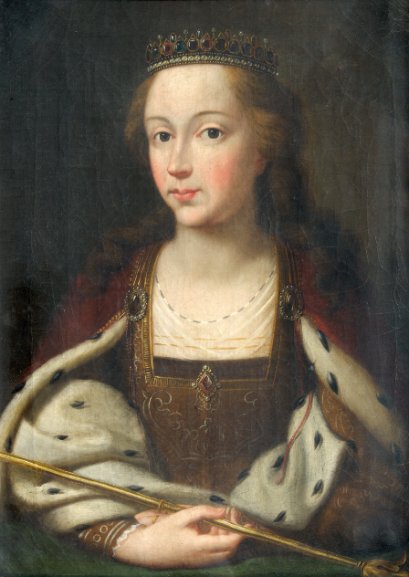 |
Margaret of Anjou was the Queen of England.
As the wife of incapacitated Henry VI, she
would be equally guilty of
provoking the onset of the War of the Roses.
Margaret was raised in France. She
married English King Henry VI at age 15.
Henry VI was not a successful king.
Henry was more interested in religion and
learning than in military matters.
When he married Margaret, his mental
condition was already unstable.
Margaret cursed Catherine of Valois.
As daughter to the mentally disturbed French
King Charles VI, now doubt Catherine had
passed on this hereditary condition to
Margaret's son Henry VI.
In
1452,
England was falling
apart. Richard, the Duke of
York was persuaded to return from Ireland,
claim his rightful place on the council and
put an end to bad government. His cause was
a popular one and he soon raised an army at
Shrewsbury. The
Lancaster group,
meanwhile, raised their own similar-sized
force in London.
Margaret took charge while Henry simply
wrung his hands.
1453 was much worse. First Henry
learned that England had lost the Hundred
Year's War with France. Then he
learned that Margaret was pregnant which was
fairly miraculous since Henry had not been
intimate. However, he was so out of it
that Margaret was able to persuade Henry
that he had merely forgotten their liaison.
Shortly after his son Edward was born in 1453, Henry
suffered a nervous breakdown.
Now rumors
were rife that the new Prince of
Wales was the result of an adulterous
affair. Perhaps it was this knowledge
that pushed Henry VI over the edge.
After his breakdown, Henry VI was judged
incapable of ruling. So Richard, Duke
of York, was appointed to run the Kingdom.
Richard immediately assumed control.
Not so fast. Margaret of Anjou, Queen
of England, refused to accept any
arrangement that deprived her newborn son - Edward
of Westminster - of his birthright.
Queen Margaret was determined to secure the
throne for her son Edward, but since he was
just a baby, she had no choice but to allow
the Duke of York to take over.
|
| |
|
Queen Margaret would stop at nothing.
Although the Lancasters were nominally aligned
behind King Henry VI, his ill health ensured that he
was never a major player in the coming War of the
Roses. The de facto leader of the Lancaster
faction was instead Henry's cunning wife Margaret.
As the most skilled strategist of the Lancasters,
Queen Margaret was hell bent on putting Richard
in his place.
|
| |
|
Edmund
Beaufort
|
| |
|
Edmund Beaufort, 2nd Duke of Somerset, was
Richard of York's main rival. Edmund was just
as ambitious to become King as Richard. Like
Richard, Edmund noted that Henry VI was still
childless after seven years of marriage. Were
Henry VI to remain without an heir, who would be the
next in line for the crown? Edmund assumed he
had a strong claim. If Henry VI could trace
his right to the throne by pointing to John of Gaunt
and Blanche, well, then Edmund could point to John
of Gaunt and Katherine Swynford.
|
| |
|
Unfortunately Richard of York could make a better
claim. Richard could point to his mother's
lineage from Lionel and his father's lineage from
Edmund. Therefore Richard's claim was stronger
than Edmund's. This explained why Richard was
named Henry's heir presumptive.
Edmund
was disgusted. To hell with Richard of York.
Edmund was going to get the crown by hook or crook.
One of his first moves was the 1427 seduction of
Catherine of Valois, the widowed mother of Henry VI,
age 5.
As the
daughter of French King Charles VI, Catherine was viewed
with considerable suspicion by English
nobles. Afraid she would implant
French sympathies into her son's gullible mind, they prevented
her from playing a full
role in her son's upbringing. Largely
cut off from her son and stuck in the court of a
foreign land that did not like her, Catherine was
pretty much bored, beautiful, and lonely.
Sensing easy pickings, Edmund Beaufort initiated a
torrid affair in 1427.
|
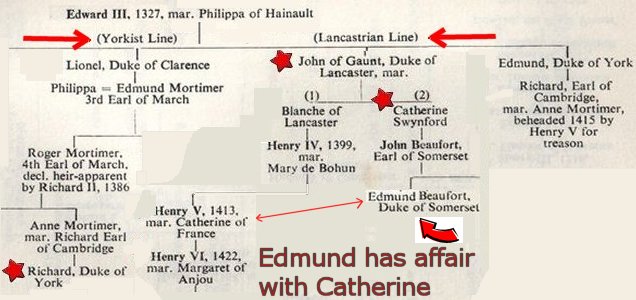 |
This
shook up the English Council. The last thing
they needed was a messy marriage and more heirs.
So they passed a law forbidding Catherine to marry
without the King's approval.
Although
the current king, Henry VI, was quite likely to give
his mother the necessary approval, there was a
catch. Henry was only 7 years old. Until
Henry came of age (16), he could not legally give
approval. Mom would have to stay single.
Very clever.
No
problem. Edmund used his position as
Catherine's one-time sweetheart to become closer to
Henry VI. He did his best to become a a
surrogate father to the boy.
Later,
Edmund would exploit his personal relationship by
persuading the King to promote Edmund to various
royal offices.
|
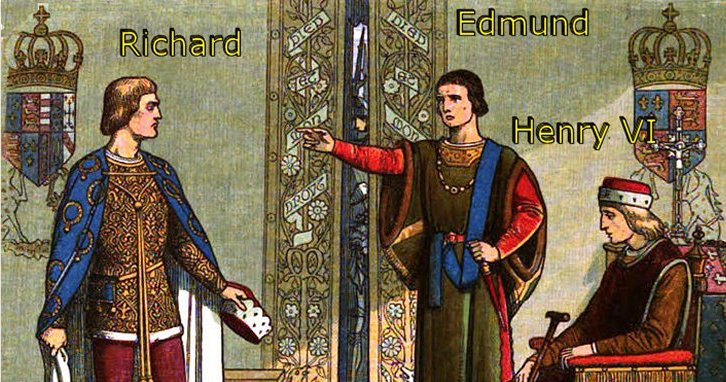 |
Richard had a
huge wealth advantage.
Although Edmund was the head of one of the
greatest families in England, his
inheritance was worth only 300 pounds.
By contrast his rival Richard had a net
worth of 5,800 pounds. Henry VI made
sure that Edmund was
compensated with offices worth 3,000
pounds. Not only did that bring Edmund
deep within Henry's inner circle, Edmund had
money to raise armies with.
This
patronage served to offend Richard of York
and many of the other nobles deeply. As Edmund's
quarrel with York grew personal, the
dynastic situation got worse, especially in
1451 when Edmund became Henry VI's right
hand man.
Edmund used his inside track in another way.
Edmund was not only Henry's right hand man,
he enjoyed the considerable advantage of
sleeping with the King's wife. When it
was announced in January 1453 that Queen
Margaret was pregnant after seven years of
no results, the matter seemed highly
suspicious.
Henry VI displayed qualities that would have
done credit to a monk, but not to a Medieval
King who was expected to produce an heir.
Henry was pious, naïve, chaste, and prudish.
In addition, Henry VI had a well-known
aversion to physical contact.
Seven years had passed without a pregnancy.
Therefore the pregnancy became seen as
either a miracle or the product of adultery.
Henry VI
himself did nothing to
squelch the rumors. When
asked about the
child's paternity,
Henry declared that Edward must have
been fathered by the Holy Ghost.
Nor did it help that Edmund was made the
child's godfather. The odds clearly
favor Edmund Beaufort as the father of this
child. However, what is more important
is that Henry VI was not the father.
Richard of York knew this and so did
everyone else. Margaret and Edmund
were trying to promote an illegitimate child
to the throne.
|
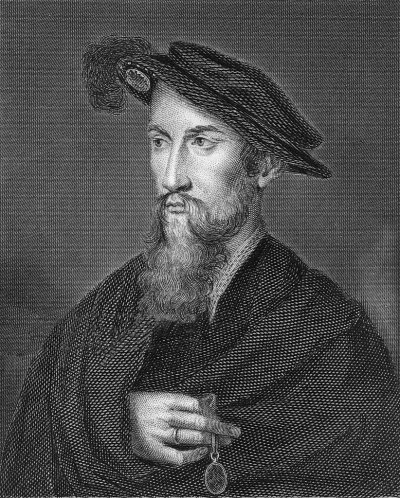 |
Despite
the objections of Margaret and Edmund, in 1454
Richard of York was named regent as Protector
of the Realm.
Richard
of York, meanwhile, had gained a very important
ally, Richard Neville, Earl of Warwick, one of the
most influential magnates of the
realm. Warwick was
an English nobleman, administrator, and military
commander. He was possibly richer than
Richard of York himself.
Richard Neville became
known as Warwick the Kingmaker due to his
considerable influence during the infighting to
replace Henry VI.
Warwick
was originally a supporter of King Henry VI.
However, a territorial dispute with Edmund Beaufort,
Duke of Somerset, led him to collaborate with
Richard, Duke of York, in opposing both Beaufort and
the king. The alliance between Richard and
Warwick was aided by the fact that Richard's wife
Cecily Neville was Warwick's aunt.
Once
Richard of York took power, the landscape changed
immediately. Queen
Margaret was excluded
from the Council
completely. Edmund Beaufort's fortunes changed
the moment his rival Richard
of York assumed power as Lord Protector. Richard had
Beaufort imprisoned in the Tower of London and began
looking for reasons to execute him.
Then Richard set about
destroying Beaufort's reputation. Richard's
York supporters spread rumors that the king's
child was illegitimate and that
Beaufort was the father.
Then Richard got to work.
His months as regent were spent tackling the
problem of government overspending.
|
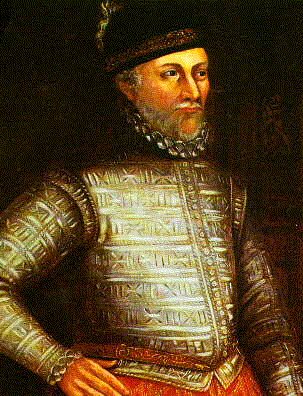 |
Still,
there was the curious issue of Margaret's pregnancy
for Richard to deal with. Margaret gave birth
to a son in October 1453. Margaret immediately
took great pains to quash rumors that Beaufort might
be his father. During her pregnancy, Henry had
suffered a mental breakdown, leaving him in a
withdrawn and unresponsive state that lasted for one
and a half years. This medical condition,
untreatable either by court physicians or by
exorcism, plagued him throughout his life.
Unfortunately for Richard
of York, the birth of baby
Edward removed him from the succession to the
throne. The child was baptized Edward, Prince
of Wales, with Edmund Beaufort listed as godfather.
If the King could return to consciousness, Margaret
intended to persuade Henry to make Edmund Beaufort legal heir to the throne
and protectorate of the Realm till the boy came of
age.
Unfortunately, the King was too far gone to do any
such thing, so Richard's dreams of being king were
still on track.
Then came the
worst surprise of all... Henry woke up.
After a
17-month bout with mental illness, Henry VI remarkably
recovered his reason in January 1455.
As historian Robin Storey
put it: "If Henry's
original insanity was a
tragedy, his recovery was a national disaster."
The
first
thing Henry did was demote
Richard back to the ranks of civilian. Then he
lost little time in reversing
most of Richard of York's actions.
This was a shame because Richard's decisions had
drawn praise for his
even-handedness and willingness to tackle
long-standing problems. Now his initiatives were cut short by
Henry's return. The reforms were
swiftly undone and Richard’s intentions were eyed
with suspicion by the court, members of whom were
the ones who had been disadvantaged by the changes.
Henry
then agreed to recognize baby Edward as his heir,
putting to rest any concerns about a successor.
Richard was out of luck.
Edmund
Beaufort's life was saved by the King's seeming
recovery. Edmund was freed from captivity and
restored to his former position of power.
Having reconvened the court at Westminster by
mid-April 1455, Henry and a select council of nobles
decided to hold a great council at Leicester.
York and his closest allies anticipated that Edmund
Beaufort would bring charges against them at this
assembly.
Seeing
Beaufort released and returned to favor was the last
insult that York would take from his nemesis.
Richard of York was beyond bitter. He was
determined to depose of Beaufort by one means or
another. In May 1455 he raised an army and
tracked down the Beaufort army headed to Leicester.
He confronted Somerset and the King in an engagement
known as the First Battle of St Albans which marked
the beginning of the Wars of the Roses. His son,
Henry, never forgave York and Warwick for his
father's death, and he spent the next nine years
attempting to restore his family's honour.
Facing
with being declared outlaws and traitors, the Yorks
gathered an armed retinue and marched to stop the
royal party from reaching Leicester, intercepting
them at St Albans.
|
|
First Battle of
St. Albans, 1455
On May
22, 1455, Richard, Duke of York engaged the forces
of King Henry VI of England at the First Battle of
St. Albans.
Richard's army outnumbered Henry's army 7,000 to
2,000. Richard attempted to negotiate.
He told Henry to hand over Edmund Beaufort and he
would walk away. Henry stuck by his closest
confidante and refused to give him up.
After
two hours, Richard lost his patience and ordered the
attack. Dividing his forces in two
parts, his first attack failed badly. Warwick
took the second unit through an unguarded part of
the town's defenses, through back lanes and gardens.
|
|
|
|
|
Suddenly
Warwick discovered the market square where the main
body of Henry's troops were talking and resting.
Henry's
men were not yet expecting to be involved in the
fighting. Many were not even wearing their
helmets. Warwick charged instantly with his
force, routing the Lancastrians. Edmund
Beaufort knew that Richard of York would never let
him live. When the Yorkists surrounded his
building, Beaufort was killed in a last wild charge
from the house where he had been sheltering.
Beaufort charged onto the main street and killed
four men before being struck down himself.
His son,
Henry, never forgave York and Warwick for his
father's death. He would spend the next nine
years attempting to restore his family's honor.
The
sudden attack and bravery shown by Warwick began his
famous military career. It would later help
form his nickname as 'The Kingmaker'.
After the battle, Richard of York escorted King
Henry back to London. Richard was appointed as
Protector of England by the parliament a few months
later. Henry VI sat in the Tower of London.
The War of the Roses had begun.
|
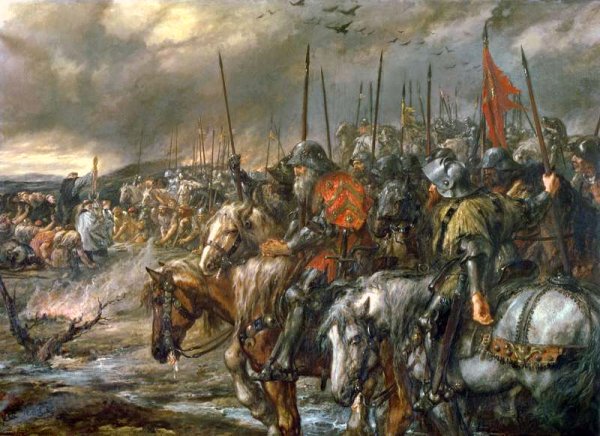 |
Battle of
Wakefield, 1460
|
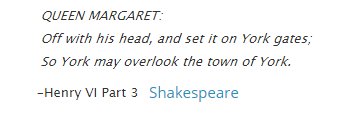 |
|
|
|
Over the
next five years, there were rises and falls in the
fortunes of both camps. The Lancasters won the
1459 Battle of Ludford Bridge. Warwick and
Richard both fled across the English Channel for
safety.
In
December 1459 York and Warwick suffered 'attainder', a
legal process that says their lives were forfeit and
their lands reverted to the king. Nor could
their heirs inherit the lost estate.
This was
the most extreme punishment a member of the nobility
could suffer. Now Richard of York was in the
same situation as Henry of Bolingbroke (the future
King Henry IV) in 1398. Only a successful
invasion of England would restore his fortune.
Assuming the invasion was successful, York had three
options: become Protector again; disinherit the king
so that York's son would succeed; or claim the
throne for himself.
It was finally
agreed upon that Richard would not
only rule, he would become king upon
Henry's death. Only one
problem. Within a few weeks of
securing this agreement, Richard
died in the 1460 Battle of Wakefield
(as did Richard Neville, Earl of Salisbury and
father of Warwick the Kingmaker).
Richard
of York and his forces convened at Sandal Castle, Richard's
stronghold. A small detachment of Lancastrians
were spotted nearly. Instead of awaiting
reinforcements, Richard led an impulsive charge on
the Lancastrians. It was a trap. Two
large forces of the Lancastrian army emerged from
nearby woods and quickly destroyed Richard's men. Richard, 49,
and his son Edmund,
17, died in the battle.
Why
Richard had exposed himself has never been clear.
One possibility is betrayal by some northern lords who
Richard mistakenly believed to be his allies.
Another explanation was overconfident rashness on York's part.
On the order of warrior queen Margart of Anjou, the heads of
Richard and his son Edmund were placed on pikes by
the victorious Lancastrian armies and displayed at
the Micklegate Bar
in York. Richard's head bore a paper crown. The insult was
clear... after all these years, Richard wore his
cherished crown.
Neither Warwick nor
Richard's eldest son Edward, 19, was at this
battle. When Edward learned that he had lost his father and
younger brother in the
fight, he vowed to avenge the
ambush.
|
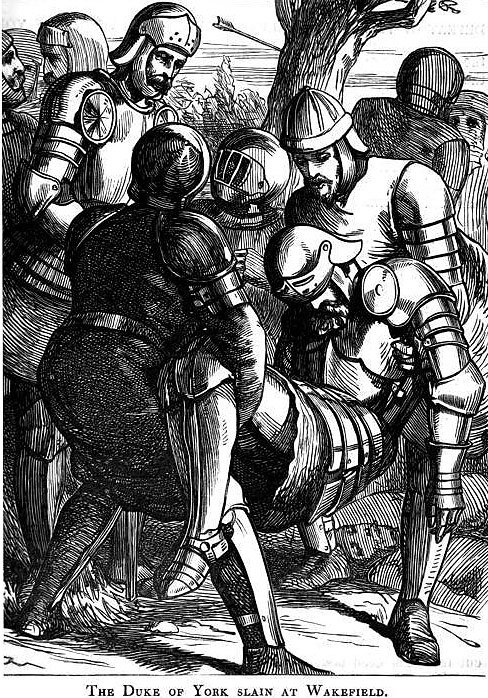 |
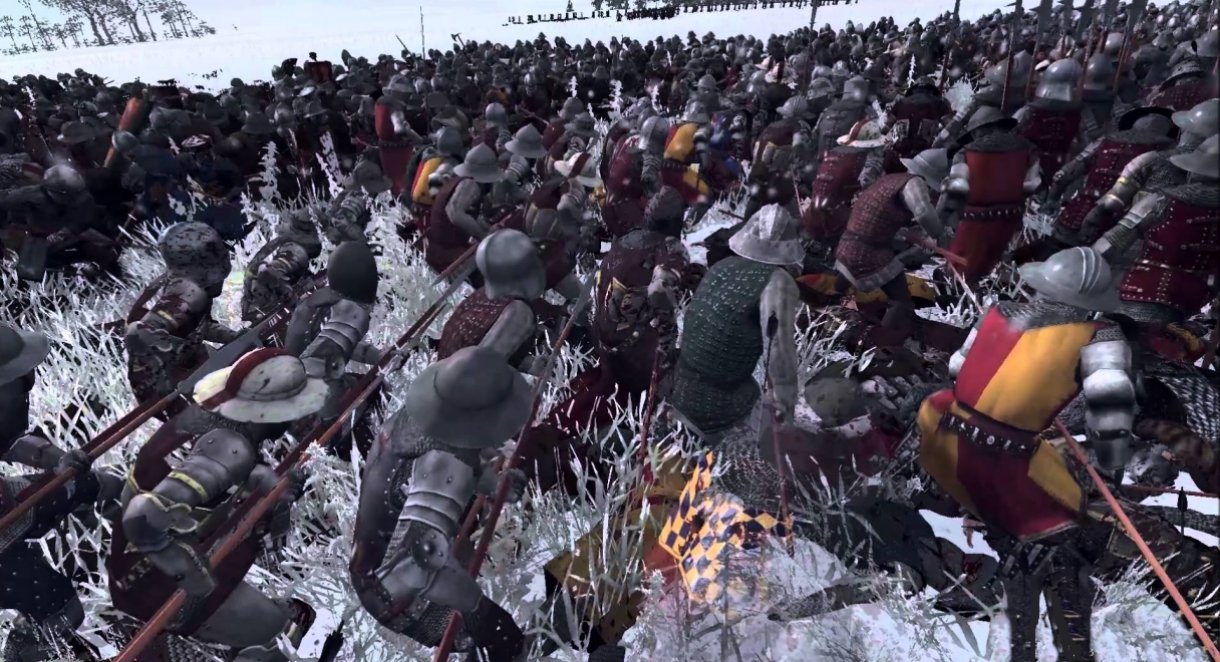
Battle of Towton,
1461
The
death of Richard of York shook a lot of people up.
In a sense, the Lancasters had killed the future
king. This was not viewed well by the majority
of people. Richard had the same opportunity to
murder Henry VI on two occasions, but had shown the
restraint and respect not to do so.
Instead,
after the Yorkists had
captured Henry in 1460, they had taken the political
route. Indeed, the English parliament
passed an Act of Accord which would
allow Henry to remain as king with the understanding
that Richard would be Regent and would take over
upon Henry's death.
The
Act of Accord was a legally binding
agreement. In a sense, Margaret had broken the
law. Margaret did not care. Margaret of
Anjou would never accept the
decision to remove her son's right to the throne
under any circumstances.
Might makes right. Along with fellow malcontents, she
raised a massive Lancaster army that far out-numbered the York
side.
|
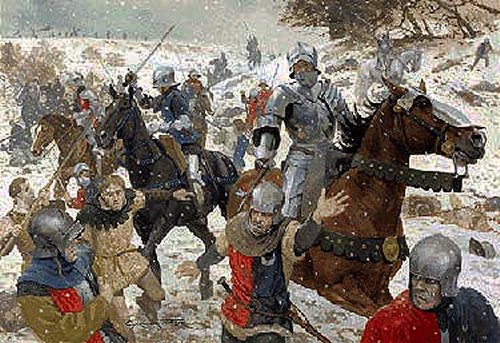 |
| |
After Richard of York was ambushed
and killed at the Battle of Wakefield, nobles who
were previously hesitant to support Richard's claim
to the throne considered the Lancastrians to have
reneged on the Act. Edward found enough
backing to denounce Henry and declare himself King.
The
Battle of Towton was to affirm the victor's
right to bypass the law and rule over England through force of arms.
The battle was
fought in the snow on 29
March 1461, near the village of Towton in Yorkshire.
This was
the grudge match, winner take all.
The York
side was commanded by William Neville, Lord
Fauconberg, a former Lancastrian who had changed
sides to join his nephew Warwick. Fauconberg
faced long odds. He was heavily outnumbered
and part of their
force under the Duke of Norfolk had not yet arrived.
The
initial fighting favored Lancaster, but Lord Fauconberg
saw a way to turn the tables.
Taking note of the powerful wind at their back,
Fauconberg ordered his archers to use the strong
wind to outrange their enemies.
|
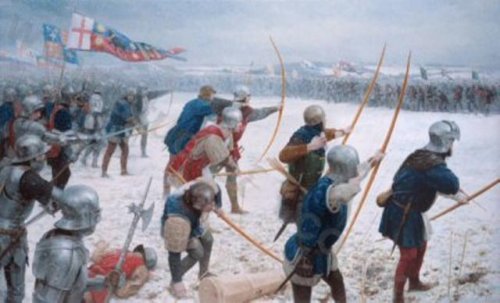 |
| |
This
began a
one-sided missile exchange. The Lancaster arrows
fell short of the Yorkist ranks while the York
arrows forced the
Lancastrians into abandon their defensive
positions and retreat to safety.
However,
now that the York side had exhausted their
ammunition, the stronger Lancaster army regrouped
and prepared to charge. Noticing the countless
Lancaster arrows on the ground that had fallen
short, the Yorkist archers plucked the fallen arrows in front of them and continued shooting.
The Lancaster side was hit with a crippling second
barrage.
The
ensuing hand-to-hand combat lasted hours, exhausting
the combatants. The 'better late than never'
arrival of Norfolk's men reinvigorated the Yorkists.
Now they surged forward and routed their foes.
The fighting lasted ten hours. Many
Lancastrians were killed while fleeing; some
trampled each other and others drowned in the
river and snow streams, said to have run red
with blood for several days.
Towton has
been described as the largest and bloodiest
battle ever fought on English soil.
According to chroniclers, more than 50,000
soldiers from the Houses of York and Lancaster
fought for hours amidst a snowstorm on that day,
which was Palm Sunday. A
newsletter circulated a week after the battle
reported that 28,000 died on the battlefield.
|
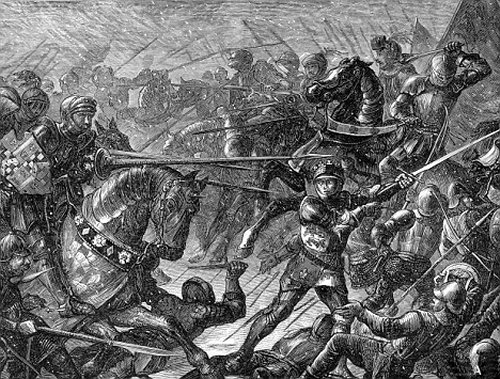 |
Battle of Hexham,
1464
Following the 1461 Battle of Towton, Henry VI, Margaret,
and her son Edward fled to Scotland to lick
their wounds. It turns out that Towton was not
the end. Margaret of Anjou still had fight in
her. Margaret of Anjou was hated by the
English because she was so ruthless. That
said, did she have any choice?
Margaret's entire existence was wrapped around
restoring Henry VI to the throne and protecting her
son's birthright to be the future king. It was
up to her to fight her husband’s battles and her
son's battles.
After
the 1461 Towton battle, as acting head of the House
of Lancaster, Margaret was able to get the families
to regroup in the north, their base of power.
In 1463, Margaret instigated a rebellion to disrupt
a peace process Edward had initiated with Scotland
further to the north.
Edward
sent John Neville, Warwick's brother, to put down
the rebel force. John Neville was better known
as Montagu since he was the 1st Marquess of Montagu.
Montagu effortlessly put down the poorly organized
uprising.
At the
end of the battle Henry VI was captured again.
Strange as it must seem, this was now the third time
the poor senile man was captured in battle.
Why they kept trotting this poor, senile figurehead out on the
battlefield is a mystery. How weird is it to
keep using a mindless king as a mascot?
|
| |
|
There is
an interesting story attached to the Battle of
Hexham. Margaret insisted on viewing each
battle herself. She was a warrior Queen if
there ever was one. She also insisted Edward
always be at her side for fear as assassination.
Therefore young Edward’s life was spent hurrying
from battlefields to either triumph or exile.
After
the Lancastrians were defeated at the Battle of
Hexham in 1463, Margaret, seized with mortal terror
for the life of her boy, fled with him on foot into
an adjacent forest. Driven by dread, she took
any path she could find just to get as far away from
her enemies as possible. Margaret and Edward,
10, were ambushed by robbers who took Margaret's
jewels and costly outer robes.
While
the outlaws quarreled over who got what, Margaret
snatched her son up in her arms and fled to a
distant thicket to hide. When the robbers
could not find them, they gave up and left.
After waiting hours to be sure the men were gone,
Margaret and Edward came out from hiding.
Wandering lost through the forest, they soon fell
into the hands of another outlaw later that night.
Queen Margaret led her boy up to him and said,
“Here, friend, save the son of your king.”
Surprisingly, the robber took pity on them and hid
them in a cave for two days. The outlaw
spotted one of Margaret’s captains who was searching
for them and told the man where the Queen could be
found them. The captain took Margaret and
Edward to Scotland, whence they finally escaped to
France where they would live with Margaret's
relatives as exiles.
After
the battle, Montagu showed none of King Edward's
conciliatory spirit. Montagu had thirty leading
Lancastrians executed in Hexham on the following day. Maybe this cold-hearted treatment was
necessary. After all, Edward's penchant for showing mercy had not
solved the problem. Like zombies, after every
battle, the Lancasters seemed to get back up and start fighting
again. Not any more. These executions did the trick.
Warrior queen Margaret of Anjou had fled the
country, Henry VI had lost his mind and the
Lancaster leaders had lost their heads.
Lancaster resistance collapsed.
|
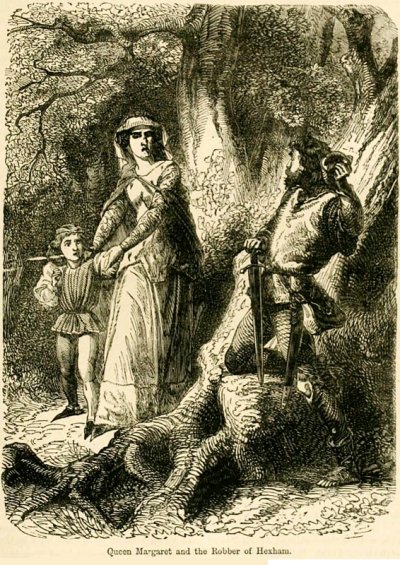 |
| |
|
Meanwhile, Edward IV took Henry’s crown and
consolidated his 1461 claim to become England's
first Yorkist king. Edward
did a smart thing. By law, he could have
confiscated the estate of virtually every
Lancastrian noble. Most of
England's leading families had remained loyal to
Henry VI or remained uncommitted in the recent
conflict. Edward did indeed seize the estates of all the
Lancaster nobles who had died during the fighting,
but offered to let the rest keep their lands on
promise of loyalty. This worked like a charm.
Peace came to the land for the time being.
England was done fighting, but only for a while.
In the
aftermath, the new regime relied
heavily on the support of Warwick
and the Neville family who had been so instrumental in bringing Edward to the
throne.
Not long after Edward IV
began his reign, Warwick the Kingmaker decided to
become a
Queenmaker instead.
Now that
the fighting had ended, Warwick began casting about for a
suitable Queen for the bachelor king. This
endeavor would lead to one of the strangest stories
in history.
|
Next Chapter:
War of
the Roses II
Coming soon!
|
|